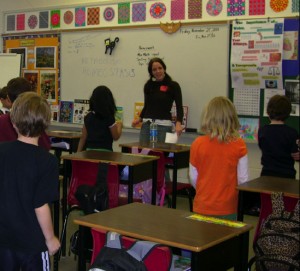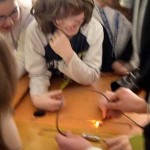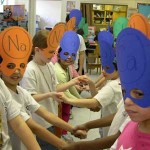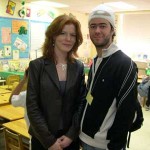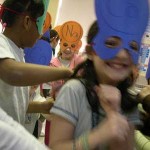Ion Channel Proteins
October 6, 2011 in Protein
On Monday, February 25th, 2008, the students in Mrs Shuster’s third grade class at École F.A.C.E. School were charged-up by the discussion of university students Christine Sherrington (BFA Art Education, Concordia U.) and Nazim Ait Yahia (B.Sc., U. Montréal) as they presented “ion channel proteins” in our fifth Molecules of Life Project (MLP) in Montreal.
Christine and Nazim ask the students many questions and created a discussion that illuminated the presence of ions in food, such as calcium in milk, and sodium and chloride in salt, as well as the importance of ion channel proteins for controlling the flow of such ions into the cells of the body.
Employing a battery, two wires and a light bulb to create a circuit, Nazim illuminated the students with thoughts on the flow of ions from high to low charge and related ion channels to switches that regulate the flow of ions in and out of cells.
Showing an animation, Christine discussed how the ion channels form protein pores through the lipid (fatty) membrane of the cell.
The students then tied on masks to become ions, and aligned themselves into two lines touching hands with their partners to form an ion channel protein. Listening to Latin rhythms, the students danced the “ion channel salsa” in which they took turns being passed along the channel as ions, and passing their fellow students through the channel behaving like the side-chains of the amino acids which control the flow of ions in the ion channel protein. Like ions flowing into a cell to form salts, the salsa dancers were dancing the mambo in the channel until the music stopped and the gates of the ion channel closed. When the music resumed, the gates reopened and the dancers continued dancing into the cell.
…cha, cha, cha, mambo, mambo, mambo, salsa, salsa, salsa, ion, ion, ion, stop!
Finally, we discussed the importance of ion channels in regulating the functions of different cells and tissues, such as the contractions of muscle cells, the rhythm of the heart beat and the flow of signals through the nervous system. Experiencing the great potential of this learning experience, we thanked team ion channel for regulating a positive flow of MLP movement.
For some Neuroscience For Kids:
http://faculty.washington.edu/chudler/ap.html
For a neat animation on ion channels involved in heart action:
http://www.cellsalive.com/channels.htm
for a basic review on ion channels:
http://www2.montana.edu/cftr/IonChannelPrimers/beginners2.htm



